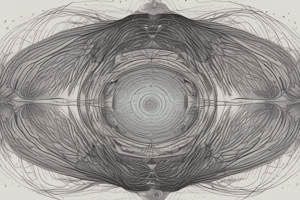Podcast
Questions and Answers
Which Gestalt principle explains why we tend to see objects aligned in a row as belonging together?
Which Gestalt principle explains why we tend to see objects aligned in a row as belonging together?
- Light-from-Above Assumption
- Law of Pragnanz (Principle of Simplicity)
- Principle of Similarity
- Principle of Good Continuation (correct)
If someone is shown an image and perceives it in the simplest way possible, which principle is at play?
If someone is shown an image and perceives it in the simplest way possible, which principle is at play?
- Oblique Effect
- Law of Pragnanz (Principle of Simplicity) (correct)
- Environmental Regularities
- Principle of Similarity
Which type of processing relies primarily on prior knowledge and expectations to interpret sensory information?
Which type of processing relies primarily on prior knowledge and expectations to interpret sensory information?
- Bottom-up Processing
- Parallel Processing
- Serial Processing
- Top-down Processing (correct)
The 'oblique effect,' where vertical and horizontal orientations are more easily perceived, is an example of which?
The 'oblique effect,' where vertical and horizontal orientations are more easily perceived, is an example of which?
Assuming that light is coming from above when interpreting a scene is an example of what?
Assuming that light is coming from above when interpreting a scene is an example of what?
Helmholtz's theory of unconscious inference suggests that our perceptions are primarily shaped by what?
Helmholtz's theory of unconscious inference suggests that our perceptions are primarily shaped by what?
Which of the following best describes the Gestalt psychologists' primary objection to structuralism?
Which of the following best describes the Gestalt psychologists' primary objection to structuralism?
According to Gestalt psychology, what role does past experience play in shaping our perceptions?
According to Gestalt psychology, what role does past experience play in shaping our perceptions?
The phenomenon of apparent movement, where rapid sequential flashes of stimuli in different locations are perceived as motion, provides evidence for which of the following?
The phenomenon of apparent movement, where rapid sequential flashes of stimuli in different locations are perceived as motion, provides evidence for which of the following?
Which scenario best exemplifies the Gestalt principle of good continuation?
Which scenario best exemplifies the Gestalt principle of good continuation?
What key methodological difference distinguishes Donders' work on reaction times from earlier, purely philosophical approaches to understanding the mind?
What key methodological difference distinguishes Donders' work on reaction times from earlier, purely philosophical approaches to understanding the mind?
Why is Wilhelm Wundt considered the 'father of experimental psychology'?
Why is Wilhelm Wundt considered the 'father of experimental psychology'?
In Ebbinghaus's memory experiments, what does the 'savings' score represent, and why was it important?
In Ebbinghaus's memory experiments, what does the 'savings' score represent, and why was it important?
A researcher wants to replicate Donders' experiment but uses visual stimuli instead of auditory stimuli. Participants must press one button if they see a red square and another if they see a blue square. What is being measured?
A researcher wants to replicate Donders' experiment but uses visual stimuli instead of auditory stimuli. Participants must press one button if they see a red square and another if they see a blue square. What is being measured?
How did Wundt's method of analytic introspection attempt to study the mind, and what was a major limitation of this approach?
How did Wundt's method of analytic introspection attempt to study the mind, and what was a major limitation of this approach?
Which component of a neuron is primarily responsible for receiving signals from other neurons?
Which component of a neuron is primarily responsible for receiving signals from other neurons?
What is the primary function of the axon in a neuron?
What is the primary function of the axon in a neuron?
What is the key difference between the Nerve Net Theory and the Neuron Doctrine?
What is the key difference between the Nerve Net Theory and the Neuron Doctrine?
Ebbinghaus's savings curve demonstrates that memory retention changes over time. What is the general trend observed in this curve?
Ebbinghaus's savings curve demonstrates that memory retention changes over time. What is the general trend observed in this curve?
Which of the following best describes the role of a synapse?
Which of the following best describes the role of a synapse?
What was the significance of Camillo Golgi's staining technique in the study of neurons?
What was the significance of Camillo Golgi's staining technique in the study of neurons?
In the context of memory and learning, what does 'higher savings' generally indicate?
In the context of memory and learning, what does 'higher savings' generally indicate?
How did Ramon y Cajal's work build upon that of Camillo Golgi?
How did Ramon y Cajal's work build upon that of Camillo Golgi?
The serial position effect describes a specific pattern in memory recall. Which statement accurately describes this effect?
The serial position effect describes a specific pattern in memory recall. Which statement accurately describes this effect?
What implications can be derived from forgetting curves regarding effective learning strategies?
What implications can be derived from forgetting curves regarding effective learning strategies?
What is the role of sensory receptors in neural communication?
What is the role of sensory receptors in neural communication?
Within a single neuron, how are signals typically transmitted?
Within a single neuron, how are signals typically transmitted?
How did William James contribute to the field of psychology?
How did William James contribute to the field of psychology?
What was the primary focus of the behaviorist approach in psychology during the early to mid-1900s?
What was the primary focus of the behaviorist approach in psychology during the early to mid-1900s?
In Pavlov's experiments with dogs, what was the conditioned stimulus?
In Pavlov's experiments with dogs, what was the conditioned stimulus?
What was the main objective of John Watson's Little Albert study?
What was the main objective of John Watson's Little Albert study?
Damage to Wernicke's area is most likely to result in which of the following?
Damage to Wernicke's area is most likely to result in which of the following?
Which lobe of the brain is primarily responsible for processing auditory information and memory?
Which lobe of the brain is primarily responsible for processing auditory information and memory?
A patient has difficulty maintaining balance and coordinating movements. Which area of the brain is most likely affected?
A patient has difficulty maintaining balance and coordinating movements. Which area of the brain is most likely affected?
Which of the following best describes distributed representation in the brain?
Which of the following best describes distributed representation in the brain?
What does the term 'connectome' refer to in the context of brain function?
What does the term 'connectome' refer to in the context of brain function?
Which of the following methods is used to measure functional connectivity in the brain while a person is not performing a specific task?
Which of the following methods is used to measure functional connectivity in the brain while a person is not performing a specific task?
What is the significance of the Default Mode Network (DMN) in the context of brain function?
What is the significance of the Default Mode Network (DMN) in the context of brain function?
Which of the following exemplifies structural connectivity?
Which of the following exemplifies structural connectivity?
Perception is best described as:
Perception is best described as:
Which of the following is an example of interoception?
Which of the following is an example of interoception?
Flashcards
Mental Chronometry
Mental Chronometry
The study of reaction times to infer cognitive processing.
Simple Reaction Time
Simple Reaction Time
The time taken to react to the presence or absence of a single stimulus.
Choice Reaction Time
Choice Reaction Time
The time to respond to one of two or more stimuli.
Wilhelm Wundt
Wilhelm Wundt
Signup and view all the flashcards
Ebbinghaus and Forgetting Curve
Ebbinghaus and Forgetting Curve
Signup and view all the flashcards
Savings Curve
Savings Curve
Signup and view all the flashcards
Forgetting Curves
Forgetting Curves
Signup and view all the flashcards
Serial Position Effect
Serial Position Effect
Signup and view all the flashcards
Context Dependence
Context Dependence
Signup and view all the flashcards
Functionalism
Functionalism
Signup and view all the flashcards
Behaviorism
Behaviorism
Signup and view all the flashcards
Classical Conditioning
Classical Conditioning
Signup and view all the flashcards
Little Albert Study
Little Albert Study
Signup and view all the flashcards
Likelihood Principle
Likelihood Principle
Signup and view all the flashcards
Unconscious Inference
Unconscious Inference
Signup and view all the flashcards
Gestalt Psychologists
Gestalt Psychologists
Signup and view all the flashcards
Principles of Good Continuation
Principles of Good Continuation
Signup and view all the flashcards
Bottom-Up Approach
Bottom-Up Approach
Signup and view all the flashcards
Axon
Axon
Signup and view all the flashcards
Dendrites
Dendrites
Signup and view all the flashcards
Synapse
Synapse
Signup and view all the flashcards
Neuron Doctrine
Neuron Doctrine
Signup and view all the flashcards
Nerve Net Theory
Nerve Net Theory
Signup and view all the flashcards
Action Potential
Action Potential
Signup and view all the flashcards
Neurotransmitters
Neurotransmitters
Signup and view all the flashcards
Receptors
Receptors
Signup and view all the flashcards
Wernicke's Aphasia
Wernicke's Aphasia
Signup and view all the flashcards
Occipital Lobe
Occipital Lobe
Signup and view all the flashcards
Frontal Lobe
Frontal Lobe
Signup and view all the flashcards
Temporal Lobe
Temporal Lobe
Signup and view all the flashcards
Brain Stem
Brain Stem
Signup and view all the flashcards
Cerebellum
Cerebellum
Signup and view all the flashcards
Distributed Representation
Distributed Representation
Signup and view all the flashcards
Structural Connectivity
Structural Connectivity
Signup and view all the flashcards
Functional Connectivity
Functional Connectivity
Signup and view all the flashcards
Default Mode Network
Default Mode Network
Signup and view all the flashcards
Law of Pragnanz
Law of Pragnanz
Signup and view all the flashcards
Principle of Similarity
Principle of Similarity
Signup and view all the flashcards
Top Down Processing
Top Down Processing
Signup and view all the flashcards
Bottom Up Processing
Bottom Up Processing
Signup and view all the flashcards
Oblique Effect
Oblique Effect
Signup and view all the flashcards
Study Notes
Cognitive Psychology: History and Overview
- Cognitive psychology is the study of mental processes enabling human function—the mind.
- The mind creates mental representations of the world and controls functions like perception, attention, memory, emotions, language, decision-making, and reasoning.
- Cognition involves mental processes—perception, attention, and memory—in understanding and interacting with the world.
- This includes recognizing, recalling, communicating, reasoning, problem-solving and making judgements.
- Cognitive tasks enable us to survive and function well, are a symbol of creativity and intelligence, and build mental world representations for interacting within it.
Early Attempts to Study the Mind
- Fechner and Weber (psychophysics): In 1854 Germany, they began to theorize on measuring mental processes. Fechner, a physicist, studied how physical differences translated into psychological experiences.
- Weber, a physician, and Fechner found our experiences don't always match objective differences. Our perception of differences relies on the starting point (reference dependence).
- Paul Broca (1861, France): Linked specific brain parts with specific mental functions, demonstrating the mind and brain's close relationship (localization of ability).
- Broca's aphasia: A language production deficiency resulting from frontal lobe damage.
- Franciscus Donders (1868, Netherlands): Early cognitive psychology experiments focused on reaction times (mental chronometry). Distinguishing between simple reaction time (responding to one stimulus) and choice reaction time (responding to multiple stimuli), determining decision-making time.
- Wilhelm Wundt (structuralism and introspection): 1879, Germany established the first psychology lab and course to study human experience structure. The father of experimental psychology, he officially called himself a psychologist.
- Structuralism: An approach explaining perception as the sum of elementary sensations.
- Analytic introspection: Trained participants described their experiences and thoughts in response to stimuli.
Hermann Ebbinghaus (Forgetting and Savings Curves)
- Studied memory. Used nonsense syllables to determine repetitions needed to recall lists without errors.
- Savings: A measure of memory retained after a learning and relearning period.
- Savings Curve: Visual representation showing rapid memory decay in the first few days after learning, then stabilizing.
- Forgetting Curves provide a sense of how much/quickly we forget. Serial Position Effect: Items at the beginning and end of a list are easier to recall than those in the middle.
William James (Psychology text and Course)
- 1875 (US): Taught the very first US psychology course at Harvard, and wrote the first US treatise on psychology (Principles of Psychology) in 1890.
- Functionalism: Focused on observable functions of the mind instead of experiments.
Behaviorism (Early-Mid 1900s)
- Behaviorism focused on observable behavior, eschewing study of the subjective mind.
- Ivan Pavlov: Discovered classical conditioning through stimulus-response pairing (conditioned and unconditioned stimuli).
- John Watson: Founded behaviorism, aiming to predict and control behavior through observable behaviors. Famous for the Little Albert study.
- B.F. Skinner: Introduced operant conditioning, emphasizing reinforcement (stimulus-response-reinforcement). Experimented by reinforcing rats to show how behavior could be maintained/increased.
- Edward Chace Tolman: Disagreed with behaviorism. His rat experiments showed that rats created cognitive maps.
- Edward Thorndike: Suggested that animal learning involved goal-directed behavior (trial and error learning) based on assuming thought processes in animals. Focused on educational psychology.
Cognitive Revolution (1950s-1960s)
- A shift in psychology towards explaining actions based on the mind.
- Influenced by computer science, inspired by the concept of information processing through stages in computers.
- Information-processing approach: Describes the mind as sequentially processing information through stages.
- Ulric Neisser coined "Cognitive Psychology" in his 1967 book, significantly marking the Cognitive Revolution.
Memory and Neuroscience
- Atkinson and Shiffrin (1968) proposed a three-stage model of memory: sensory, short-term, and long-term memory.
- Long-Term Memory: Large, long-lasting storage system with different types—episodic (life events), semantic (facts), and procedural (physical skills).
Neuroscience, Methods, and Technologies
- Neuropsychology: Studies behavior in brain-damaged individuals, comparing with non-damaged individuals.
- Electrophysiology: Examines electrical responses of nervous systems, including neurons.
- Brain Imaging: Techniques like fMRI create images of brain activity in response to cognitive tasks.
- PET (Positron Emission Tomography) and fMRI (Functional Magnetic Resonance Imaging): Used to see brain areas activated during activity.
- Functional Connectivity: Examines correlation of neural activity in different brain regions. Used methods like Resting state fMRI to determine functional connectivity of separated structures.
Localization of Function
- Localization of Function: Different brain areas perform specific jobs.
- Neuropsychology(comparison), Neuron recordings(stimulating neurons to isolate and measure activity in certain parts of the brain), and Brain imaging(looking at the pictures of brain activity with certain tasks to help find localization areas).
- Broca's Area: Involved in language production.
- Wernicke's Area: Involved in language comprehension.
- Occipital Lobe, Frontal Lobe, Temporal Lobe, Brain Stem, Cerebellum, Parietal Lobe, Motor Area, and Sensory Area
Distributed Representation
- Distributed Representation: Cognition activates many brain areas. Different brain areas are interconnected (neural networks).
- Connectome: structural map of brain network elements/connections.
- Structural connectivity: Brain "wiring diagram" created by axons (connections). Unique to individuals.
- Functional connectivity: Interaction among neurons within the connectome, determined by correlated activity.
- Dynamics of Cognition: Brain's activity and flow change constantly (even at rest). Default mode network: The brain's largest resting-state network, associated with mind-wandering, self-reflection.
Perception
- Perception: Sensory stimulation resulting in experiences.
- Senses (sight, hearing, taste, touch, smell, movement, balance, interoception).
Basic Concepts
- Percepts change with additional information. Perception is similar to reasoned problem-solving, sometimes unconsciously. Percepts occur concurrently with actions (adaptive).
- Stimulus Energy -> Sensory Receptors -> Neural Impulses -> Brain
- Kinesthetic: Body position/movement, coordination; Receptors in muscles/joints.
- Vestibular: Head position/movement (balance); Receptors in inner ear.
- Inverse Projection Problem: Determining the object from retinal images. Perceptual system solves this ambiguity.
Information Used in Human Perception (Bottom-Up vs. Top-Down)
- Bottom-Up (Data-Based): Processing starts with sensory receptor input. Features combined to create recognition.
- Top-Down (Knowledge-Based): Involves prior knowledge; percepts are actively constructed by expectations/prior knowledge.
Historical Perspectives on Perception
- Hermann von Helmholtz: Recognized ambiguous retinal images and introduced the likelihood principle (we perceive the most likely object based on stimuli). Introduced unconscious inference (perceptions as unconscious assumptions about the environment).
- Gestalt Psychologists: Proposed principles of perceptual organization, emphasizing innate mental organization.
Gestalt Assumptions and Principles
- Perception depends on Gestalt organizing principles, not just retinal stimuli.
- Role of experience is limited compared to these built-in principles (bottom-up approach). Experience influences perception but isn't the key driver.
- Apparent Movement: Perception of movement when stimuli in different locations flash with proper timing.
- Principles of perceptual organization for grouping elements (Principles of Good Continuation, Pragnanz/Simplicity, Similarity, Closure).
Regularities in the Environment (Top-Down Processing)
- Physical Regularities: Environment-specific physical properties (oblique effect demonstrates vertical/horizontal preference). Light-from-above heuristic (light often comes from above).
- Semantic Regularities: Scene schemas (knowledge of typical scene content).
Bayesian Inference
- Bayesian inference: Our outcome probability estimate depends on prior probability (initial belief) and likelihood (evidence's consistency with the outcome).
Experience-Dependent Plasticity
- Experience shapes the nervous system (e.g., perceptual systems change with experience).
Perception and Action
- Perception pathway (ventral/what): Visual cortex to temporal lobe.
- Action pathway (dorsal/where): Visual cortex to parietal lobe.
- Mirror neurons: Neurons responding during actions watched or performed. Evidence in fMRI studies.
Studying That Suits You
Use AI to generate personalized quizzes and flashcards to suit your learning preferences.




